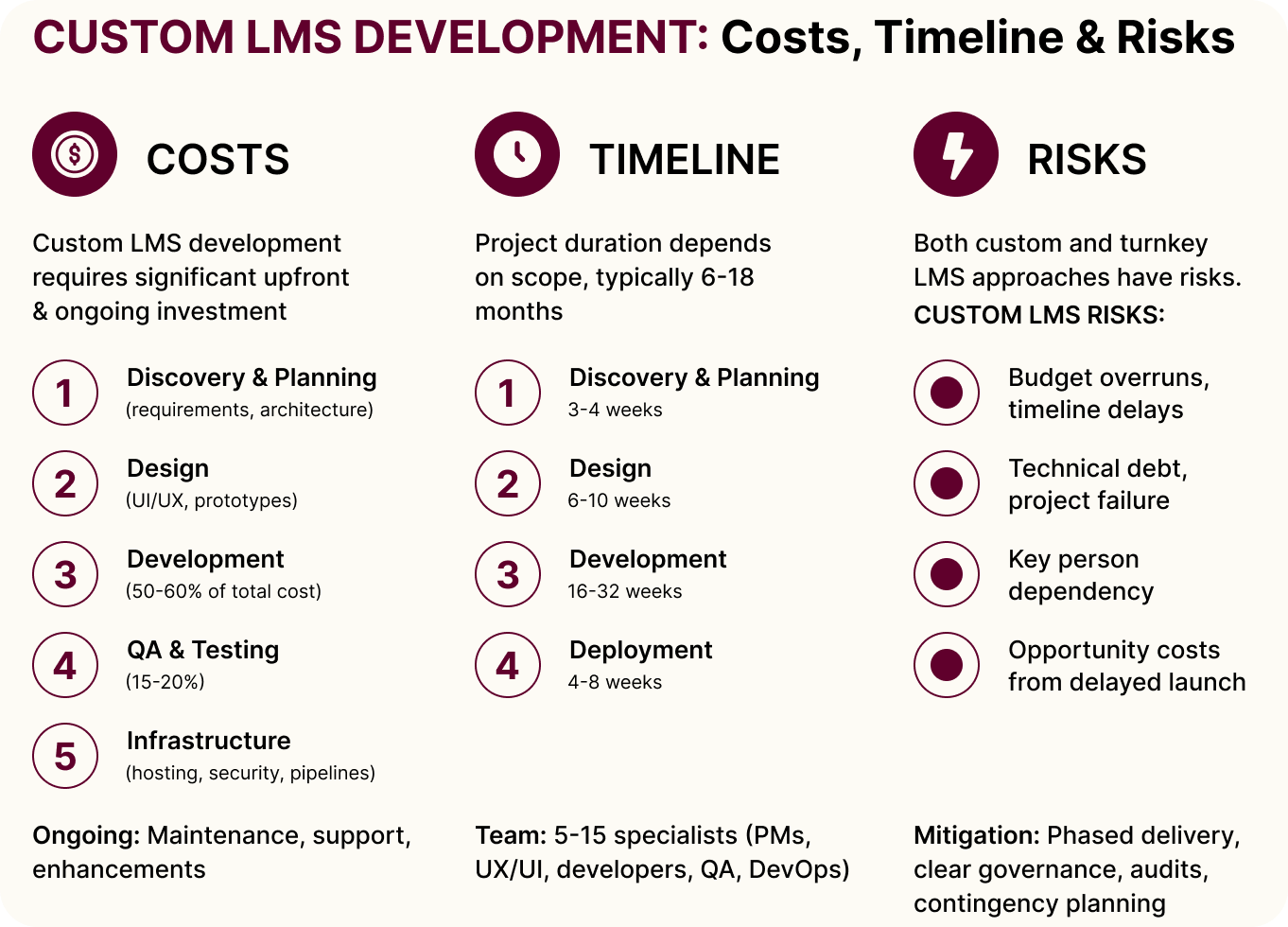When to Invest in a Custom Learning Management System vs. Turnkey Solutions

Once a decision to digitize learning in an organization is made, businesses face the need to choose the type of LMS software they need and can afford. Selecting between custom learning management systems and turnkey platforms is a thorough, uneasy process with many variables requiring consideration. The right choice depends on business requirements, budget, timeline, and long-term strategic goals.
On the one hand, custom learning management systems for businesses offer unlimited flexibility and competitive differentiation. Yet, they require significant investment and extended development timelines of 6-18 months. On the other hand, turnkey solutions provide immediate deployment, proven functionality, and predictable costs, serving as a viable alternative to custom LMS development. However, they may constrain unique processes or require compromising on specific requirements.
So, how should you choose the right option, and which criteria matter the most in this process? This article breaks down the concept of custom and ready-made LMS types, clarifies their differences, lays out the decision-making criteria and examines the viability of a hybrid approach to LMS development.
What Is Custom LMS Development?
The custom LMS vs off-the-shelf solutions debate centers on whether organizations should build proprietary learning platforms tailored to specific needs or purchase plug-and-play commercial products. This decision impacts technology budgets, implementation timelines, competitive positioning, and operational flexibility for years.
So, if you’re leaning towards custom LMS design, here are a couple of things you should know:
- Custom LMS development involves building proprietary learning platforms from scratch using in-house development teams or external software agencies.
- Building custom LMS from scratch typically requires 6-18 months, depending on the solution’s complexity, with substantial upfront investment in design, development, testing, and infrastructure.
- Custom learning management systems for businesses provide complete ownership of intellectual property, unlimited customization potential, and freedom from vendor constraints.
What Are Turnkey LMS Solutions?
For organizations that need to launch LMSs quickly or standardize operations across multiple departments, turnkey platforms provide a compelling alternative. They allow teams to focus on learning outcomes instead of development cycles. Here are a couple more facts about turnkey LMSs to inform your decision-making:
- Turnkey LMS solutions are pre-built commercial platforms offering immediate deployment with standard features proven across thousands of organizations.
- Ready-made LMS platforms like Canvas, Blackboard Learn, TalentLMS, and Docebo provide subscription-based access to hosted systems requiring minimal technical resources to launch.
- Off-the-shelf LMS vendors handle infrastructure, security updates, feature development, and technical support, allowing organizations to focus on content and learners rather than platform maintenance.
- Commercial LMS platforms typically deploy in 4-12 weeks with subscription-based pricing models that reduce upfront investment.
Key Differences Between Custom and Commercial Approaches
While both custom and ready-made LMSs have their pros and cons, you may find it hard to choose an optimal option. Here are the main differences for your guidance:
- Ownership differs dramatically, with custom development providing complete intellectual property rights while commercial platforms remain vendor-controlled with licensed access.
- Time-to-launch. The build vs buy LMS decision typically means choosing between 6-18 months for custom builds versus 1-2 months for turnkey implementation.
- Cost structures of pre-built and custom LMSs follow opposite patterns. Custom systems require a large upfront investment with lower ongoing costs, while commercial platforms minimize initial expense but accumulate subscription fees indefinitely.
- Flexibility represents the starkest contrast, since custom platforms adapt to any requirement without limitation, whereas commercial systems constrain customization to vendor-provided configuration options.
When Your Business Needs a Custom Learning Management System
With custom LMS development requiring lots of time and money, businesses may be reluctant to choose this option if they face pressing timing or budgetary constraints. In many cases, custom LMSs are not even recommended as a redundant investment. Yet, in some situations, businesses can’t do with pre-built solutions and can rely only on custom software. Here are three main situations when investing in custom LMS is a non-negotiable option.
- Standard commercial platforms cannot accommodate core business requirements.
- Training processes provide competitive differentiation.
- Unique compliance needs exceed turnkey capabilities.
Unique Business Requirements That Justify Custom Development
The need to develop a custom LMS is often determined by a unique business architecture, specialization, or set of business requirements it needs to comply with. Here are some examples of complex business processes requiring custom LMS:
- Custom solution scenarios include proprietary assessment methodologies that commercial platforms cannot replicate.
- Organizations may need specialized content formats unsupported by standard systems.
- Complex approval workflows specific to organizational structure also justify custom development.
- Custom LMS solutions support multi-tiered certification programs with intricate prerequisites.
- Custom-built LMSs can accommodate competency frameworks aligned to proprietary job architectures.
- Unique credentialing systems tied to regulatory requirements also demand custom platforms.
Industry-Specific and Compliance-Driven Needs
Industry-specific LMS needs frequently drive custom development in heavily regulated sectors. Standard platforms often lack the required functionality for these industries. Here’s how compliant custom development works in specific industry cases:
- Compliance-driven custom LMS scenarios include financial services organizations needing integration with proprietary risk management systems.
- Healthcare providers require HIPAA-compliant training delivery with specialized clinical documentation.
- Defense contractors need security clearance verification built directly into learning platforms.
Specialized learning requirements also vary by industry. For instance, pilot training demands real-time simulation integration. Manufacturing requires equipment diagnostics embedded in maintenance certification programs. Customer-facing organizations need training portals that match exact brand specifications and integrate with existing customer relationship management systems. Each of these needs is industry-specific and cannot be factored into a pre-built LMS structure.
Competitive Advantage Through Custom Learning Platforms
Custom LMS development is always beneficial in competition terms because a custom-tailored learning technology directly impacts market positioning or customer experience. For example, organizations selling training as products require platforms that reflect brand identity precisely. They need unique pricing models and seamless integration with sales systems that commercial platforms cannot provide.
Strategic differentiation through learning technology proves most valuable when training drives measurable revenue, retention, or operational efficiency. A useful illustration is a software company selling certifications, which might build custom platforms that become revenue centers themselves. These platforms process payments, manage credential marketplaces, and provide partner portals that generate competitive moats. This way, both a competitive advantage and meaningful differentiation in saturated markets are attainable only with the help of custom solutions, built for specific business needs and not that easy to replicate.
When Commercial LMS Limitations Become Deal-Breakers
Turnkey LMS features and limitations create deal-breakers when vendors cannot support critical requirements through configuration alone. Here’s what can go wrong at the stage of pre-built LMS adoption:
- Configurable commercial LMS constraints typically surface in data architecture inflexibility. Such platforms may require data structures incompatible with existing systems, or reporting limitations where standard analytics cannot answer critical business questions.
- Integration restrictions represent common breaking points, as many commercial platforms limit API access, constrain data synchronization frequency, or cannot connect with legacy systems essential to operations.
While these restrictions are not critical for some businesses, they play a vital role for others, urging businesses to reconsider LMS solutions in favor of custom LMS development.
Custom LMS Development: Costs, Timeline, and Resources
Embarking on a custom LMS project means balancing creative freedom with disciplined planning. Custom LMS development cost varies widely based on feature complexity, integration requirements, and desired scalability, requiring substantial upfront investment before launch. Therefore, before coding begins, teams must understand the real cost of building ownership and independence.
At the heart of custom LMS development lies proper timing and development team setup. Custom LMS development timeline spans 6-18 months from requirements gathering through deployment. Human resources for custom LMS development include product managers, UX designers, front-end and back-end developers, QA engineers, and DevOps specialists, typically totaling 5-15 full-time team members.
Complete Cost Breakdown of Custom LMS Development
Custom learning management system pricing breaks down into five major categories.
- Discovery and planning cover requirements analysis, user research, technical architecture planning, and project roadmapping.
- Design expenses include user interface mockups, user experience flows, visual design systems, and interactive prototypes.
- Cost to develop custom LMS in the development phase consumes 50-60% of the total budget.
- Testing and quality assurance add 15-20% to development costs.
- Infrastructure setup, including hosting, security configuration, and deployment pipelines, requires additional initial investment.
It’s also important to note that custom LMS project phases continue beyond launch with maintenance, support, and feature enhancements requiring ongoing annual investment.
Development investment by component includes:
- Core learning functionality. Course management, content delivery, learner enrollment, and progress tracking form the foundation, requiring substantial investment for robust implementation with a modern user experience in mind.
- Assessment and certification. Quiz engines, testing capabilities, automated grading, rubric systems, and certificate generation add considerable development effort depending on assessment sophistication and anti-cheating requirements.
- Reporting and analytics. Custom reporting interfaces, data visualization, learning analytics, and business intelligence dashboards require significant investment for enterprise-grade capabilities beyond basic completion tracking.
- Integrations. Connecting with HRIS, SSO, video platforms, content authoring tools, and other systems adds substantial cost per major integration, depending on API quality and data complexity.
Development Timeline and Project Phases
How long it takes to build a custom LMS depends on scope, team size, and methodology, but typical projects follow four major phases.
- Discovery and planning span 3-4 weeks.
- The design phase requires 6-10 weeks for user research, wireframing, visual design, and prototype testing.
- Custom LMS implementation timeline enters development for 16-32 weeks, building features iteratively with regular testing and stakeholder feedback.
- The final deployment phase spans 4-6 weeks, covering user acceptance testing, data migration, training development, and phased rollout to production environments.
With these estimates in mind, you can set realistic timeline expectations custom LMS for mid-sized projects with standard features totaling 6-12 months from kickoff to launch. Complex enterprise systems with extensive integrations may require 15-18 months.
Risk Assessment for Both Approaches
Every LMS initiative carries risks, but understanding them upfront reduces the chance of unpleasant surprises later. Here are the main risks to anticipate:
- Risks of custom LMS development include project failure, budget overruns, timeline delays, technical debt accumulation, key person dependencies, and opportunity costs from delayed deployment. Custom software projects frequently experience budget and schedule challenges according to industry research on software project success factors.
- Turnkey LMS vendor risks encompass vendor acquisition or shutdown, forced migrations, price increases, feature stagnation, security breaches, service outages, and loss of competitive differentiation.
The good news is that risks are generally avoidable with a proper approach. Mitigating LMS project risks requires clear governance, phased funding, regular stakeholder reviews, and contingency planning for both approaches. Risk mitigation for custom development includes phased delivery with incremental value, external audits of technical quality, maintaining vendor independence through modern architectures, and documenting systems comprehensively.

Hybrid Approaches: Starting with Turnkey and Customizing Later
Those who need custom LMS solutions but can’t afford them for various reasons at present may opt for a hybrid, or phased LMS approach. It combines turnkey deployment for immediate needs with planned custom development once requirements crystallize through actual usage. This alternative offers many tangible benefits, such as:
- Starting with commercial then customizing allows organizations to begin training quickly, validate workflows with real users, and develop detailed requirements based on experience rather than theoretical planning.
- Gradual migration to custom proves especially valuable when organizations lack certainty about requirements, face urgent deployment pressure, or want to derisk investment through staged implementation.
Conclusion
Both turnkey and custom LMSs come with pros and cons, which need to be weighed before making the final selection. Custom learning management systems for businesses deliver unlimited flexibility, competitive differentiation, and complete control at the cost of substantial investment, longer timelines, and ongoing maintenance responsibility. Turnkey platforms provide proven functionality, rapid deployment, and predictable costs while constraining customization and creating vendor dependencies.
The wisest way to go is to evaluate both options systematically using decision frameworks that weigh criteria according to strategic business priorities. The decision ultimately depends on whether learning technology represents strategic differentiation or operational necessity, whether unique requirements justify custom investment, and whether your organization possesses the capability to execute LMS development successfully.
Frequently Asked Questions






